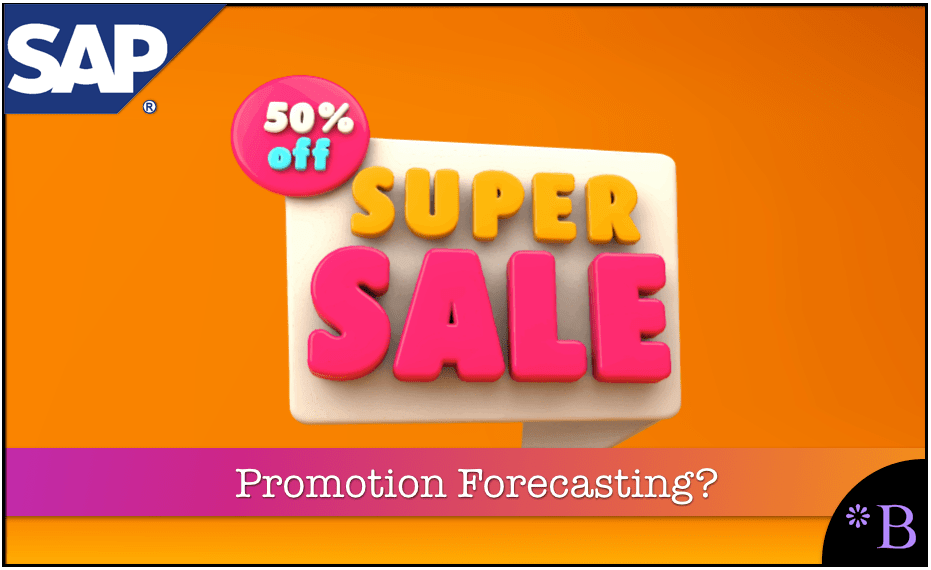How to Understand Promotional Forecasting in SAP DP
Executive Summary
- What are Promotions?
- Promotional Forecasting in SAP DP.
- Promotional Planning and Lifecycle Planning.

What Are Promotions?
Promotion planning is designed to model one time events or repeating events. Promotions are a problem because they spike demand artificially and affect the demand history of the promoted item but often reduce the demand for related items. This demand history for each of the items must be permanently adjusted or normalized because a promotion occurred. If a seasonal forecasting method is used without adjusting for this, the forecast will be higher for that item than the demand will likely be (absent another promotion). The opposite problem will be felt for the substitute items.
Our References for This Article
If you want to see our references for this article and other related Brightwork articles, see this link.
Notice of Lack of Financial Bias: We have no financial ties to SAP or any other entity mentioned in this article.
- This is published by a research entity, not some lowbrow entity that is part of the SAP ecosystem.
- Second, no one paid for this article to be written, and it is not pretending to inform you while being rigged to sell you software or consulting services. Unlike nearly every other article you will find from Google on this topic, it has had no input from any company's marketing or sales department. As you are reading this article, consider how rare this is. The vast majority of information on the Internet on SAP is provided by SAP, which is filled with false claims and sleazy consulting companies and SAP consultants who will tell any lie for personal benefit. Furthermore, SAP pays off all IT analysts -- who have the same concern for accuracy as SAP. Not one of these entities will disclose their pro-SAP financial bias to their readers.
Promotional Forecasting in SAP DP
Clients heavily desire the promotional forecasting functionality. Rather than ask if promotions are value add, the unresearched assumption is that they are and that operations must make all the adjustments necessary to satisfy marketing’s desires to make the business as complex and unmanageable as possible.
In terms of data management, promotional key figures are added to the InfoCubes and appear in the planning books for the planners to work with.
Promotional forecasting is under the following menu path:
Demand Planning – Planning – Promotion – Main Promotion Key Figures
However, it may not make sense to use this path for the following reasons.
Promotional Planning and Lifecycle Planning
Promotional planning is strongly related to lifecycle planning in that both use factors to create uplift or downlift from the historical trend. The problem is that these functionalities in SAP DP are high maintenance and weak. Promotional planning is greatly enhanced by collaborative planning as customers can communicate their promotions to suppliers, who can adjust supply accordingly.
However, promotional planning is onerous in SAP DP. This is not to say that promotions cannot be entered into SAP DP – that can be easily done. But SAP DP is not a good environment for identifying outliers, which is the main step to making promotional adjustments. Secondly, once promotional sales are accounted for, it’s important to see reflected in both the model selected and the forecast-ability measurements. However, running the best fit procedure in DP is traditionally a pain, and the forecast-ability figures do not immediately update when the promotional adjustments are made. Finally, SAP DP is not a fully capable attribute-based forecasting system. Attributes cannot be easily changed and then added to the interface for navigation purposes. It is expensive and time consuming to adjust the hierarchy in SAP DP, so most companies don’t do it except occasionally. Once created, navigation within SAP DP is cumbersome and does not allow me to flexibly group the PLCs (product location combinations that I need to group) — providing statistics on and the group I choose to select.
I have been told that I should accept these limitations because it is SAP. However, I am not interested in working around SAP’s limitations for SAP’s sake. I am trying to solve problems for my customers, and I don’t have the timeline built into my projects to deal with SAP DP’s inefficiencies in this regard. I am not Deloitte, IBM, or Accenture. I can sit around showing no improvement in forecast accuracy for months or years or only make improvements to a small portion of the product location database. These are all options for Director’s of Forecasting or for SAP consultants on long-term implementation projects with DP that may extend to a year or more — to be “SAP” compliant. I need to improve rapidly on projects, which means using SAP DP for elementary tasks and faster-better tools for more complex tasks. Therefore, I find it far more preferable to create adjustments to the resultant history in an external application and then upload the new history to SAP DP.
Why SAP Consultants recommend this
Few SAP consultants will recommend this because of the following reasons:
- They work for large consulting companies or SAP, and if you work for either a consulting company or SAP, you have no leeway except to recommend the use of SAP — no matter how bad the fit with the business requirements.
- SAP DP consultants want to build their resume in SAP DP, not necessarily recommending what works.
- They do not offer their outside applications to perform the promotional adjustment.
- They have no idea how to perform forecasting outside of DP and don’t understand or have the background to compare to other forecasting systems.
Therefore companies that listen to SAP DP consultants end up with a poor solution concerning promotions. The fact is that most customers that use SAP DP end up being unhappy with its ability to manage promotions. And there is very little in the way of alternate viewpoints in the marketplace.